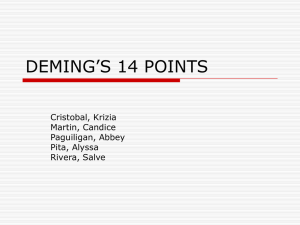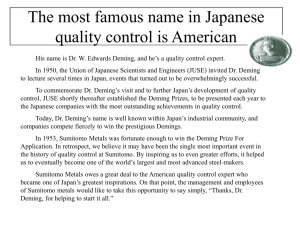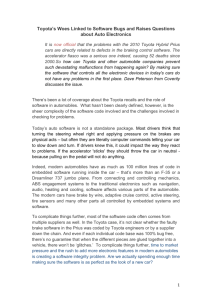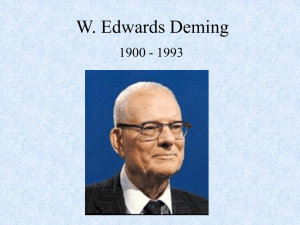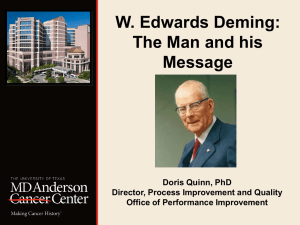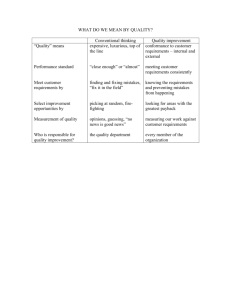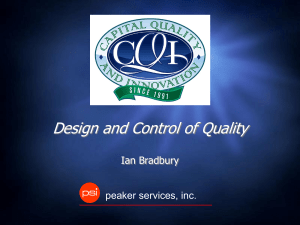Solutions - Industrial and Systems Engineering
advertisement
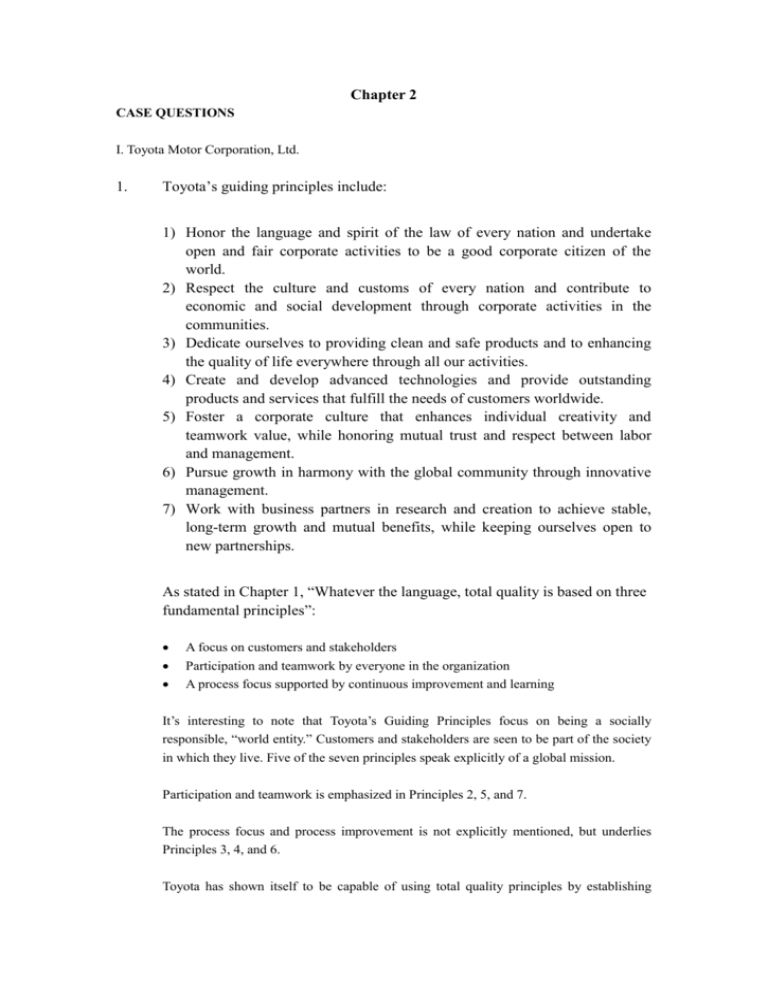
Chapter 2 CASE QUESTIONS I. Toyota Motor Corporation, Ltd. 1. Toyota’s guiding principles include: 1) Honor the language and spirit of the law of every nation and undertake open and fair corporate activities to be a good corporate citizen of the world. 2) Respect the culture and customs of every nation and contribute to economic and social development through corporate activities in the communities. 3) Dedicate ourselves to providing clean and safe products and to enhancing the quality of life everywhere through all our activities. 4) Create and develop advanced technologies and provide outstanding products and services that fulfill the needs of customers worldwide. 5) Foster a corporate culture that enhances individual creativity and teamwork value, while honoring mutual trust and respect between labor and management. 6) Pursue growth in harmony with the global community through innovative management. 7) Work with business partners in research and creation to achieve stable, long-term growth and mutual benefits, while keeping ourselves open to new partnerships. As stated in Chapter 1, “Whatever the language, total quality is based on three fundamental principles”: A focus on customers and stakeholders Participation and teamwork by everyone in the organization A process focus supported by continuous improvement and learning It’s interesting to note that Toyota’s Guiding Principles focus on being a socially responsible, “world entity.” Customers and stakeholders are seen to be part of the society in which they live. Five of the seven principles speak explicitly of a global mission. Participation and teamwork is emphasized in Principles 2, 5, and 7. The process focus and process improvement is not explicitly mentioned, but underlies Principles 3, 4, and 6. Toyota has shown itself to be capable of using total quality principles by establishing consistent standards of excellence, setting and communicating clear expectations, continuous improvement (as opposed to finding fault and blaming), looking at a work task as a process, involving all who have a stake in the outcome in the improvement process, measuring results, and recognizing and rewarding success – for bringing about change. Using a set of quality "tools," teams define a system (under the broad umbrella of the “Toyota Production System”), assess a situation, analyze causes, try out improvement theories, study results, standardize improvement, and plan continuous improvement. The three principles of total quality appear to be well supported by an integrated organizational infrastructure, a set of management practices, and a set of tools and techniques, which all work together. 2. Just as SSM Health Care learned from manufacturing, other non-profit organizations might also learn from Toyota. Their constancy of purpose and customer focus is exemplary. Their attention to detail and use of kaizen continuous improvement methods has been documented time and time again. They use best practices and share new approaches rapidly among organizational units. They treat their workers as associates, and constantly seek suggestions for improvements from their partners. Education could pick up some ideas on how to become a “learning organization” from Toyota. Government could use some lessons in how to become more “customer friendly” and how to develop more effective and efficient processes. (See the SSM media case in the Bonus Materials). Chapter 3 Discussion Question 10, 11a, 11b 10. A comparison of Deming’s “newer” version of the 14 Points versus the “original” 14 Points shows more of a “systems” emphasis. For a number of points, Deming shortened and simplified them, perhaps to eliminate the obvious duplications, and perhaps to make them easier to remember. 1. 2. 3. Create a Statement of Purpose. Originally, in Deming’s earlier version, commitment to aims and purposes of the organization by senior leaders was something that might or might not be made clear to employees throughout the organization. In the newer version, Deming urged that it be “published” to all employees. Learn the New Philosophy. Again, the older version suggested that it was primarily the job of management to adopt the new philosophy and provide leadership for change. The new version emphasizes the need for communication of values, expectations, customer focus, and learning as a key area for everyone. Understand Inspection. In the old version, it appeared that Deming wanted to end inspection (although a closer reading showed that he did 4. 5. 6. 7. 8. 9. 10. 11. 12. 13. 14. 11. not advocate ending all inspection). The newer version suggests the need to develop appropriate measurement plans and to understand where measurement should and should not be used. End Price Tag Decisions. The new version makes the simple statement, without prescribing how this should be done, as the old version did. Improve Constantly. This statement is a simplification of his old version of this point, as are the points 6, 7, 8, 10, 12, 13, and 14. He seemed to be willing to let the statements speak for themselves, rather than drawing out their implications or results. Thus it is obvious (he might say) that continuous improvement is to be done so that it will increase quality and reduce costs. Institute Training. Recognizes the critical importance of training. Teach and Institute Leadership. The new version states that leadership should be taught, as well as instituted. Drive Out Fear and Innovate. The new version of this point expands the emphasis to include developing trust and innovation, which is an interesting confluence. Deming implies that when fear is driven out, it is replaced by trust, which then can create a climate for innovation. Optimize the Efforts of Teams and Staff. This point has been broadened considerably to imply that teamwork is the activity required to deploy and optimize the aims and purposes of the organization. The older version indicated that the need for teamwork was related to removing barriers between departments so that problems could be foreseen and solved. This is not negated in the new version, but a vertical dimension is introduced, to complement the horizontal dimension. Eliminate Exhortations. Once again, Deming simplifies the old wording, to eliminate the (to him) obvious statements. Eliminate Quotas and MBO; Institute Improvement; and Understand Processes. Deming saw no need for work standards, quotas, and management by objectives approaches. He assumed that if everyone was working constantly toward process understanding and quality improvement, that there would be no need to exhort workers to work harder to meet numerical goals. Remove Barriers. This is a simplification of his previous point, which had two parts to cover workers and managers. Encourage Education. This point is similar to point 6, but takes a broader view that education, as well as training, is essential for all employees. Take Action. This is the role of leadership, but everyone has to be involved in the transformation process. a. How do senior leaders set organizational vision and values? When Horst Schulze became president in 1983, he and his leadership team personally took charge of managing for quality because they realized that managing for quality could not be delegated. They personally established the Gold Standards, which are the foundation of The Ritz-Carlton quality philosophy. b. How do senior leaders deploy your organization’s vision and values through your leadership system, to all employees, to key suppliers and partners, and to customers and other stakeholders, as appropriate? The Gold Standards, in their simplicity, represent an easy-to-understand definition of service quality and are aggressively communicated and internalized at all levels of the organization. The constant and continuous reinforcement techniques of the Gold Standards, led by senior leaders, include lectures at new employee orientation, developmental training, daily line-up meetings, administration of both positive and negative reinforcement, mission statements displayed, distribution of Credo cards, the Credo as first topic of internal meetings, and peer pressure. As a result, employees have an exceptional understanding and devotion to the company’s vision, values, quality goals, and methods. Project etc. 6, 8 6. Since approximately 45 out of the 50 states do have awards, most students will discover that their state does have such an award. The majority of awards have their own web sites, which can be used to obtain contact information, and in some cases, profiles of state award winners. 8. This is an interesting source of information on the current ISO registrations. Now that the ISO 9000:2000 requirements are fully in place, it will be interesting to see whether the trend will be toward increasing or decreasing numbers of registrations. CASE QUESTION I. TecSmart Electronics 1. TecSmart Electronics’ strengths (abbreviated) may be numbered for identification, as follows: (1) (2) (3) (4) (5) (6) Senior leaders set company objectives and guide cross-functional teams to review and develop individual plans. Senior leaders participate in quarterly communication meetings with all employees to discuss company issues and answer questions. Senior leaders teach courses in TecSmart University; meet with customers, suppliers, and benchmarking partners; and are actively engaged in professional and community organizations. The company collects operational data in every department and evaluates its information. TecSmart has set Six Sigma goals for most of its processes. All employees are trained in a 5-step problem solving process. (7) (8) (9) (10) (11) (12) (13) (14) (15) (16) (17) (18) Inputs to the strategic planning process include customer feedback, market research, and benchmarking information from customers, suppliers, competitors, and industry leaders, etc. The CEO reviews progress every month. TecSmart uses over a dozen different processes to gather customer information, and validates the information. All employees receive customer relationship training. All complaints are handled by the Vice President of Sales and resolved within 2 days. Customer satisfaction data is acquired from sales representatives, etc. and these data are reviewed and compared by the executive team during the strategic planning process. TecSmart uses self-managed work groups where employees make most day-to-day decisions while managers focus on coaching and process improvement. The average employee receives 72 hours of internal quality/service-related training. Employees have been surveyed each year to gauge how effectively the company has implemented Deming’s 14 Points. Cross-functional teams guide product development, which includes four interim reviews by executive management. New product introduction teams work with design engineers and customers to ensure that design requirements are met and SPC is used to monitor variation, provide a basis for corrective action, and optimize processes. Quality is assessed through internal audits, employee opinion surveys, and customer feedback. Suppliers are involved in early stages of a product development program and quality requirements for suppliers have been identified. When related to Deming’s new version of his 14 points we can see: 1. 2. Create a Statement of Purpose. TecSmart has a focus on quality, service, and value. This is also reinforced by #1 and #2. By making plans (#1), and cascading them down the organization, the leadership team can focus on the three key values. By holding quarterly communication meetings (#2), senior leaders can reinforce their statement of purpose. Learn the New Philosophy. A dedication to learning is shown in #3, #7, and #13. The best way to learn is to teach something, as the executives do in #3. They are also learning as they gather inputs for the strategic planning process in #7. Finally, in #13, provision is made not only for training, but learning through the quality/service-related training sessions. 3. 4. 5. 6. 7. 8. 9. 10. 11. 12. Understand Inspection. Inspection is not explicitly addresses, but items 4, 5, 6, and 8, among others, show that decisions based on facts, which can involve inspection, are routinely made. End Price Tag Decisions. The basis on which decisions are made for purchasing parts and services is not discussed. However, item #18 states that suppliers are involved in early stages of a product development program. That implies that there is a close working relationship between the company and suppliers, and that cost concerns are discussed and worked out to minimize quality issues. Improve Constantly. A process is in place to train employees in a 5-step problem solving process (#6), and new processes are documented and variation in ongoing processes is monitored for corrective action (#16). Institute Training. As stated earlier, training and learning seem to be built into the “fabric” of the company, such that executives teaching courses at TecSmart University (#3). Customer relationship training is also required for all employees (#9). Also, in #13, provision is made for 72 hours of training on service/quality topics, and sales, engineers, office staff, and managers must all be trained. Teach and Institute Leadership. Leadership is evident in objective-setting (#1), communication and teaching (#2 and 3), planning (#7), complaint resolution (#10), and middle management coaching (#12). Drive Out Fear and Innovate. While driving out fear is not specifically addressed, it seems likely that the quarterly communication sessions (#2) with top management, employee empowerment (#12) through self-managed teams, and the annual employee surveys (#14) would do a great deal to reduce or eliminate fear. Optimize the Efforts of Teams and Staff. Teams and staff have been organized and are used constantly as indicated by items 1, 4, 6, 7, 12, 15, 16, and 18. Eliminate Exhortations. Goals are set (#5) and measurement processes are used extensively (#8 and #11), but exhortations are never mentioned. Eliminate Quotas and MBO; Institute Improvement; and Understand Processes. Again, no mention is made of quotas or MBO. Understanding of the need for improvement, and to know the characteristics of processes abounds. Remove Barriers. #12 states that “Hourly workers can make process changes with the agreement of only one person, and sales people are authorized to travel wherever they feel it necessary for customer service.” 13. 14. Encourage Education. Learning, training, and education seem to all be inter-related at TecSmart. Nothing was explicitly stated about education, however. Take Action. The company has taken action to institute quality on a number of fronts, already. 2. TecSmart Electronics’ strengths (abbreviated – see above) can also be classified according to the Baldrige criteria, as follows. The seven categories in the Baldrige Criteria for Performance Management include: 1. 2. 3. 4. 16, Leadership. Items 1, 2, 3, and 7. Strategic Planning. Items 1 and 7. Customer and Market Focus. Items 8, 9, 10, 11, 15, and 17. Measurement, Analysis, and Knowledge Management. Items 4, 5, 7, 8, 11, and 17. 5. Human Resource Focus. Items 1, 6, 9, 12, and 14. 6. Process Management. Items 4, 8, 16, and 18. 7. Business Results. Items 2, 3, 4, 7 and 17. 3. It’s difficult to find “obvious” opportunities for improvement because TecSmart Electronics has so many “obvious” strengths. However, strategic planning (Category 2) appears to be an area where some improvement could take place. No mention is made of how goals are set, benchmarks are chosen, or cycles of improvement in the planning process take place. Also, other than managers who are involved in professional and community organizations, no mention is made of how the company addresses social responsibility obligations. In addition, goal setting for financial objectives is not mentioned. In Business Results (Category 7), no mention is made of processes used to track business results, or how they are compared with internal trends and external benchmarks. Also, there are no references to measurement of social responsibility results versus goals.
